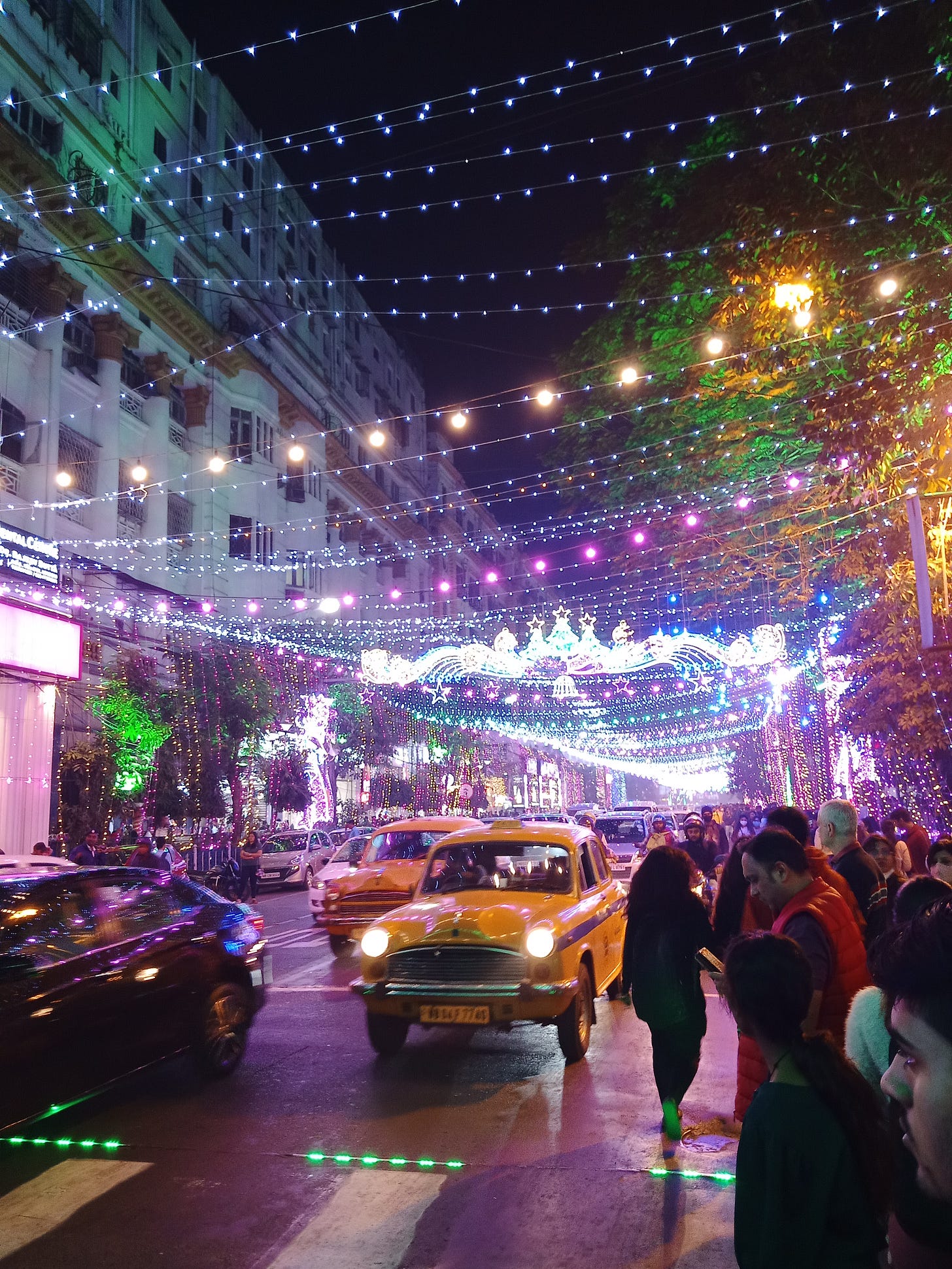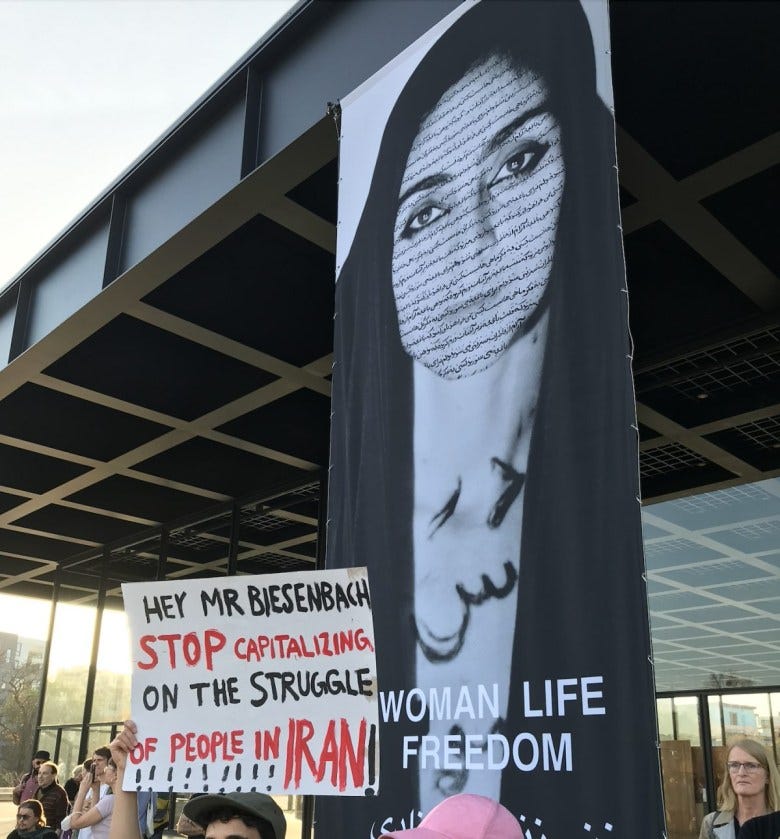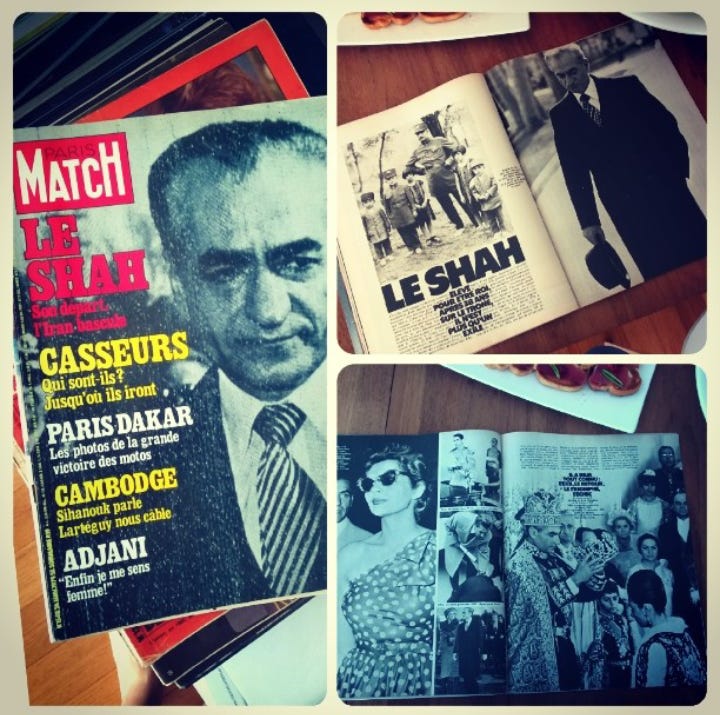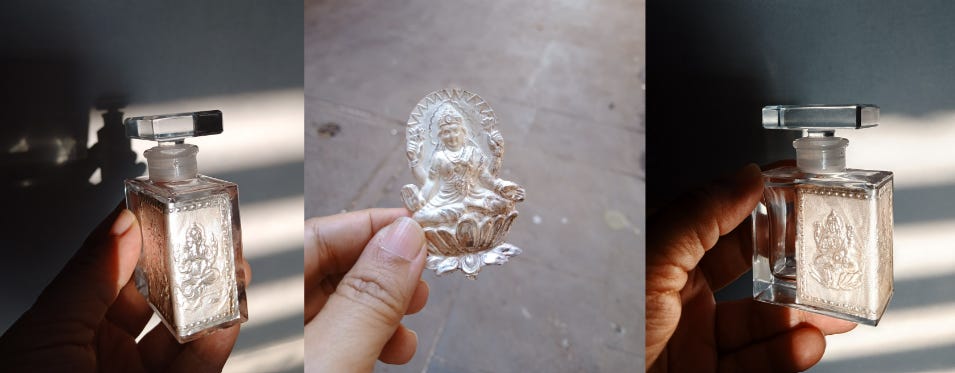(Happy new year! This one’s long read)
Perfume of the Season: Saptaparni Blooms
Early in December I formulated a tiny batch of this perfume. I am still new to the olfactory contexts of the sub-continent, so I have encountered this smell on winter evenings only over the last three years. I can best describe the fragrance as a combination of black cardamom, leather, indole and civet. And that is exactly the construction of the perfume - a peculiar approximation of the flower. My friend who tested it felt as if he had fresh blooms pressed to his nose, very much marvelling at my skill. Well, I might be the first to craft a Saptaparni perfume.
While this floral fragrance is known to most South Asians, it has not been cool enough for perfume brands to pick up because there is no context for it as a high-culture scent. There may be some association of that “cheap Indian smell” with saptaparni flowers so I took gul-hina attar (distilled flowers of Lawsonia Inermis) which possesses that peculiar South Asian “grocery store smell”, and lifted it from its heaviness with cardamom and jasmine extract. To keep its indolic facets alive (poop, pollution, smog), I overdosed it with castoreum. This is actually a perfume that sparkles on crisp winter nights - just like the blooming tree itself.
I want to say how delicious Calcutta smelled!
I afforded myself a tiny holiday to Calcutta with a friend. The weather was fantastic and the air (mostly) smelled of food and saptaparni flowers blooming on trees practically on every street! It is so wonderful to travel with someone who knows way more about the world than I do. I don’t understand economics so in ways that are opaque to me, they visibilise the nebulous nexus between political wealth, business connections, Western and domestic philanthropic foundations that indirectly impact the substance of art practices in the Third World.
“…decolonising climate change through [documentation of] sensorial anthropocene”
Apart from eating great food on our trip, we also paid close attention to contemporary artworks, texts and artists bios to note their use of language that appeals to Euramerican foundations that have already enabled their cultural practice just enough so as to attract further grants/opportunities abroad. With weak cultural structures at home, it is worth analysing how such neo-colonial funding shoehorns artists into re-producing that special-sauce orientalist gaze through video and photography in particular. Clearly meant to pander to international institutions that wish to be perceived as progressive. We saw one exhibition that produced some variation on war torn landscapes, poor brown people, Farsi script, and veiled women.
“Hey Mr. Biesenbach, stop capitalizing on the struggle of people in Iran”
A good case-study is the Iran-born American artist, Shirin Neshat. Recently, in a bid to express solidarity with protesters in Iran, some Euramerican institutions plumbed their collections to find just the one Iranian diaspora artist in their vaults to flaunt to the public.
“Iranian Artists Criticize Berlin Museum’s Display of Shirin Neshat Banner Some have questioned whether Neshat’s famous images of women wearing the hijab…” — Elaine Velie November 17, 2022; Read here
A pity that influential museums and publications can find only one token artist — who left Iran before the 1978 revolution— to provide a voice on the recent protests while those in Iran are the ones facing life and death consequences. Curiously, the Berlin museum devising a quick display of Neshat’s work also illustrates how suddenly flexible an institution can be when it wants to — and with the budget to boot!
Change my mind: Museums take public funds then pretend not to have budgets to pay artists and minimum wage art workers
The rather vague social media presence of a designer goods business set up practically overnight by an American woman in the sub-continent also came into our periphery. The little information we could glean from the non-marketing made us wonder if such businesses are indeed fronts for foreign intelligence. While living and writing art criticism in Southeast Asia (2008-2016), I have come across my share of spooks to know how they infiltrate local art scenes — not because they are genuinely interested in contributing to regional art histories but because this open fluid sphere provides an ideal cover under which they can take the intellectual pulse of a society. One of the first speculative stories I heard was of Jim Thompson, a spook hiding in plain sight in the cultural world of Southeast Asia in the 1960s.
In the perfumery sphere, it is well known that Steffen Arctander, a foundational member of International Flavors and Fragrances (IFF) in 1960, worked for the British Intelligence Service during WWII, where he applied his chemical expertise to engineer explosives. When it comes to sourcing and extracting precious raw materials from across the globe, especially from destabilised nations, one would have to be of a discreet nature. Perfumer Michelle Krell Kydd says more: Steffen Arctander: Fragrance Expert and Game Show Contestant
TOP 5 WAYS TO SPOT A SPOOK
Spooks generally tend not to do a decent job of maintaining a believable cover (because they think the natives are stupid). They are easy to identify but my point here is this: recognise and avoid. Give these saboteurs nothing.
A foreigner arrives in your city with no connections except to their embassy but very quickly becomes well linked to the business and political elite, maybe even lets slip in conversation that they know a Military General or two (true story).
A foreign “journalist” lands but their online presence is sparse and they appear to have no substantial links to the established network of local reporters and stringers.
Ease of access and funds: A foreign “entrepreneur” arrives and quickly sets up their design/ handicraft business but their social media presence appears bland, without any firm identity. Note that setting up a business means streamlining labour, sourcing, quality control, packaging, shipping, legal issues around company registration, payment systems and tax, all notoriously impossible to accomplish swiftly if one has no connections. —For contrast, it took me three years to find a way to ship perfume internationally; Four years to find a local supplier of certain raw materials within India which I was otherwise sourcing from the US.
A foreigner arrives in your city, lives there long enough to become part of the social set but disappears overnight never to be heard from again. No one has a forwarding address, and no one seems to have known them well enough in the first place. A forgettable personality with innocuous personal traits.
Claims to be an artist/ Appears to be a collector: This foreign individual is inconsistent as an artist or art collector. They want to travel and document the art scene. Frequently spends small amounts of cash to sustain a few local artists who, despite this “patronage”, make no headway in art history or in the art market (i.e. serious art critics tend not to include them in the canon at all).
*I once met an English not-a-journalist-not-a-collector who converted their highly secure flat in Se Asia into a space for exhibiting one utterly insignificant local artist and for art restoration. At the time I visited, they had flown in two conservators who had absolutely nothing to say about art at all, in fact they made no conversation, and I had to wonder what works were they restoring with all that hi-tech equipment in the first place?! Most notably, I observed their flat was entirely devoid of personal effects, but the bookshelf housed every issue of Paris Match (a weekly French language magazine) from the 1960s and 70s in which there was substantial coverage of the American war in Vietnam and Iran. It struck me as odd so I took photos (pictured above).
NEWS!
NYC based culture-writer, Naib Mian, reviewed Bagh-e Hind for the socialist feminist magazine Lux. Curated by Nicolas Roth and myself, I love how our project fittingly exists in this genuine progressive context where the discussion is entirely on practical strategies to access social equity and DIY tactics for civic engagement across the globe. Naib, astute as he is, paid close attention to our work since July 2021, while we were still in the early stages of building our online exhibition, well before we launched on 10th September 2021. At the time he was writing a piece on how diaspora artists engage with the history of the subcontinent. A year later, in July ’22, he even travelled to LA to see our first physical exhibition at the Institute for Art & Olfaction. For me, such expression of support is invaluable. For my co-curator, this is his favorite review of the project yet: “It hits the major points without being a heavy read while still offering aesthetic intrigue and enticement.” Titled “Scents of Empire”, I prefer this quality of visibility.
The Supply Chain Set-up

I ordered the finest handmade glass flacons from a manufacturer in the UK. My Indian distiller friend asked me the price per bottle and balked, but I reminded him, that glass of a certain quality is just not produced in India.
It took me over three years to find out where these niche European perfumers sourced their bottles from as no one gives out such information. Then the company I enquired with said they need 12 -14 months advance notice for an order as they custom-make limited quantities of hand poured glass but they had a box of 15ml stoppered flacons in stock that I should book quickly before that’s gone. Now, in order to avoid extortionate customs duty charges in India, I had them shipped to London instead. My perfumer friend sweetly stored them for months in her flat until my sister, who now lives in the city, could collect them for me. Poor thing made time on the coldest day on December, to make the trip to pick them up. It was a heavy bag that she packed into her suitcase and here they are finally in my hands in Poona!
To thank my sister I made a bespoke EDP that she named "Jaipur Rose", mainly a blend of rose otto and frankincense in an amber accord. I am keeping these bottles aside for bespoke fragrance commissions for now and am exploring a way to turn each one into artworks with hand-beaten silver idols rescued from their ugly plastic casing. I am referring to Sindhi mementos from the 80s and 90s (photo below) distributed to the community to mark anniversaries, weddings, and the birth of a precious male child - I like to take a hammer to these things, to literally smash the patriarchy and rescue these idols from their outdated contexts.
“You’re so clever, but people are stealing your ideas!”
My mom keeps telling me to stay off social media and stop putting my ideas up for other businesses to steal. That’s not how my creative process works. In Pune, museums, libraries and galleries are non-existant, so I visit the flower market and the tiny shops for ribbons, silver, brass, attar, textile, etc. for research. I am also cut off from my peers/friends overseas who are part of larger cultural discourses. In this isolation, I might have produced my best work yet between 2021-22 but it was through alot of tears. Success is not a given, so I would like to be visible by having most of my ideas see the light of day.
Here are my concepts— take but extend them into something wonderful:
“Scholarship as Soap”: A photo essay (pictured)
Images of my new perfume bottles merged with discarded idols, glocal material culture and religious iconography:
One last sad thing:
In 2022, I lost two friends— Tan Boon Hui and Aljai Singh.
I’ve known Boon Hui since I was at the Sotheby’s MA program in 2008-09. Over a decade he took an interest in my art criticism. Whether it was Singapore, New York or his one visit to Pune, he always took me to the nicest places for dinner and indulged me like a doting uncle. I keep repeating it is difficult to do anything without connections, so it was just nice to have someone in the art world looking out for me.
Read my interview with him: Singapore Biennale 2013 | In Conversation with Tan Boon Hui
Aljai, my genius bean to bar chocolate-smith based in Goa, made me my edible perfume chocolate for my synesthesia projects such as Bagh-e Hind. I still have two of her Gul Ishaboor (2020) chocolate bars in my fridge. I cannot get myself to eat them. As independent women, living outside the security of heteronormative support structures, figuring out “ethical business” with our little money, abundant sensitivities, devalued currencies, all on our own in this horrible world, we exchanged ideas for our future success.
Vritti Bansal wrote about my collaboration with Aljai to produce Gul Ishaboor dark chocolate: A boutique perfumery in Pune is making edible perfume












Please do little research before writting that In Pune, museums, libraries and galleries are non-existant. Pune is full of libraries museums and galleries. Your knowledge about Pune shocks me. Perhaps you have not heard of the famous Raja Dinkar Kelkar Museum of Pune where cosmetic articles are also on display. Please don't spread lies on your half based knowledge.